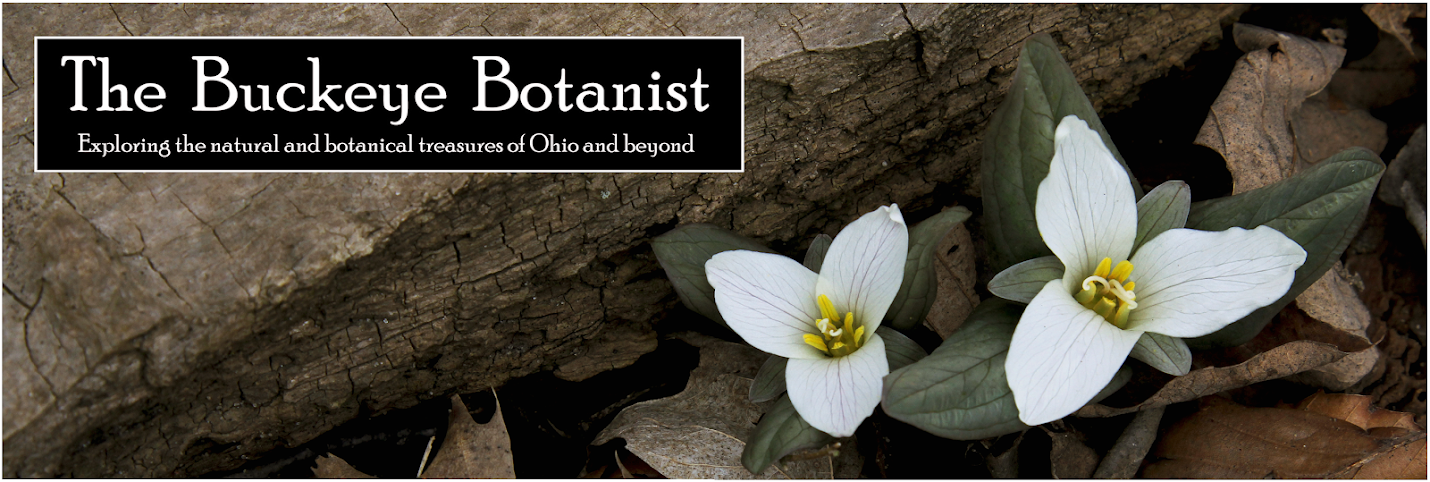On my way home this past Easter weekend I decided to make a quick pit stop at one of the most impressive little slices of Ohio natural history in my neck of the woods. In-between N. Market and N. Mulberry Streets in downtown Logan, Ohio just across from St. John's Catholic church is the aptly named Old Logan Cemetery. I'm a big fan and seeker of old cemeteries because they usually house some of Ohio's most behemoth and primordial trees and Old Logan holds a winner.
I've been focusing on observing and photographing as many of Ohio's Oak (Quercus spp.) species in flower this Spring as possible. So far I've observed seven species with at least six more still on Andrew's botanical most wanted list. As with most large trees, finding a specimen with low enough branches to get adequate, detailed macro shots is quite the task and I knew exactly which one to choose for White Oak (Q. alba).
 |
| Quercus alba - White Oak |
 |
| Quercus alba - White Oak |
I arrived a bit too early to catch this monstrosity in bloom. It was just barely starting to leaf out on some of the twigs and branches but there's never a wasted experience when in the presence of this crown jewel. I've never seen ANY tree in Ohio with as stout and thick a trunk as this. I've yet to remember to measure it when there but 6+ feet in diameter is a conservative estimate. If only trees like this could talk. I'm sure it shaded some passing Native American hunting or war parties with it's broad shoulders and served as a major landmark for early settlers and pioneers. It's weathered centuries of nature's ice, wind and rain; survived the ax and saw of the white man and continued to send its roots ever deeper to eat earth and drink water. Its true age is a mystery to me but 300+ years is probably a conservative guesstimate. Ancient, gnarled trees like this really are individuals that have their own unique scars and character to their form and appearance. I can only imagine what it was like to be in primeval Ohio, weaving in and out of similar leviathans of the open, park-like Oak-Hickory forests of old. I know what you're thinking though. What does this (as awesome as it may be) have anything to do with the curious title that lured me into reading this post anyways? It doesn't really but how could I not mention such a splendid living relic from the past before getting to the point.
 |
| Antennaria neglecta ♂ |
 |
| Antennaria neglecta ♂ |
Like many old cemeteries, Old Logan was filled several different species of common Spring wildflowers. Spring Beauties (Claytonia virginica), Common Blue Violets (Viola sororia), Cutleaf Toothwort (Cardamine concatenata) and White Trout-lilies (Erythronium albidum) were all present but it was the very cool and interestingly diecious Field Pussytoes (Antennaria neglecta) that caught my attention. Being diecious, there are separate male and female plants. Above is the male staminate plant with its orange-brown anthers protruding out like an insects sensory feelers.
 |
| Antennaria neglecta ♀ |
 |
| Antennaria neglecta ♀ |
Growing in patches not too far away from its male counterparts, the female pistillate flowers were in full bloom waiting to catch passing pollen on the wind like a small child catches a firefly from the warm, June night air. Oddly enough the female plants of A. neglecta can produce viable seed even without fertilization from the nearby staminate plants. I know I still haven't gotten to the point and I can't help but feel like the narrator from the cinema classic Monty Python and the Holy Grail that is berated by his audience with a hearty, "Get on with it!". And get on with it I will do!
 |
| Antennaria neglecta♀ with Spider |
As I moved in for a closer, more intimate shot with a pistillate inflorescence I was met with a surprise visitor through my viewfinder, sitting on top of the flower styles. I'm no entomologist so what specific species of arachnid this is I have no idea but rest assured he was tiny! The head of pistillate flower clusters on this A. neglecta was only the size of a quarter so judge the size of this guy as you may. I always love catching glimpses into the countless diminutive worlds we overlook and ignore on a daily basis and this was quite the treat. I'm very pleased with the way this photograph turned out. I took the shots without any high hopes of it being a success, macrophotography is something I'm still trying to master years into it. So now the title makes sense and everyone can breathe again, I know you were on the edge of your seats the entire time :)
























